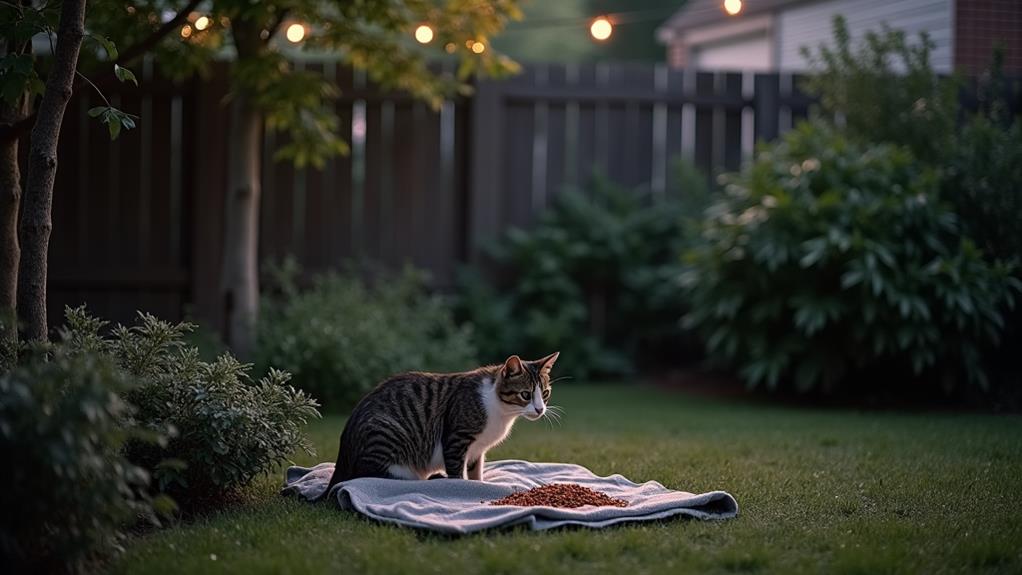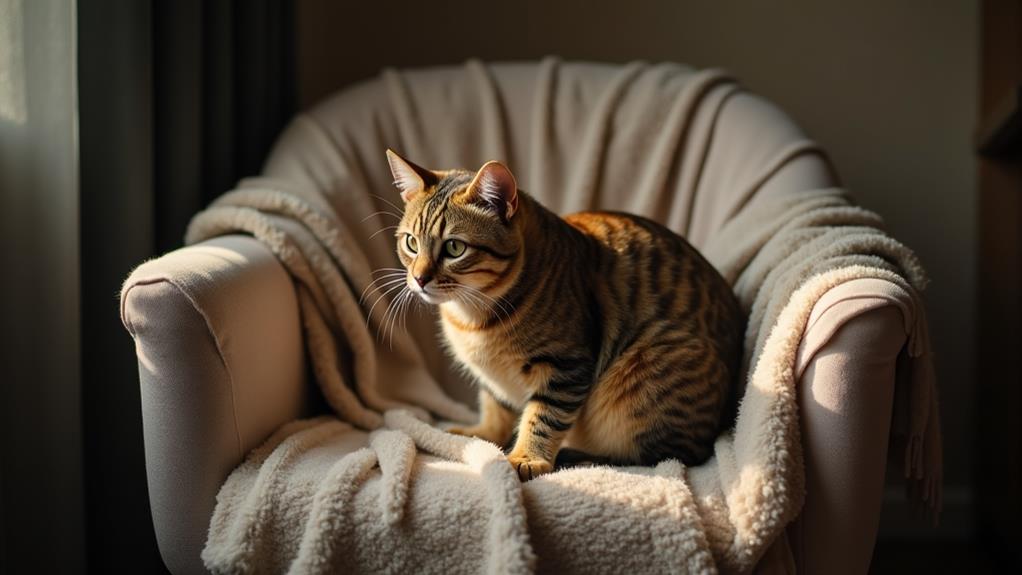How to Catch a Feral Cat With a Blanket: Step-By-Step Guide

To catch a feral cat with a blanket, initially assess its behavior and health, then find a safe, enclosed area. Gather a large, lightweight blanket, a sturdy pet carrier, gloves, and smelly treats. Choose a soft, neutral-colored blanket to calm the cat. Approach slowly and avoid direct eye contact. Lure the cat with treats and gently cover it with the blanket, creating a pouch. Support the cat gently while transferring it to the carrier, which you should line with a comforting towel. Close the carrier quickly to secure the cat. There's more to master in this method beyond these initial steps.
Assess the Situation
Before you attempt to catch a feral cat with a blanket, take some time to assess the situation carefully. Start by observing the cat's behavior. Watch for signs of stress or aggression, as these can affect your approach. Identify a safe, enclosed area where the cat frequents, such as a porch or a fenced yard, to minimize escape routes during your capture attempt. This will help you plan for any potential escapes and guarantee the cat can't slip away.
Next, evaluate the cat's health. If the cat appears sick or injured, prioritize immediate veterinary care instead of using a blanket to capture it. In such cases, it's essential to handle the situation with a veterinarian's guidance. Familiarize yourself with the cat's feeding schedule, as knowing when it's most relaxed and predictable increases the likelihood of a successful capture.
Once you've assessed these aspects, have a pet carrier nearby for a smooth transfer after catching the cat. Line it with comfortable material to make the cat's change less stressful. Taking these steps guarantees you're well-prepared and considerate of the cat's well-being during the capture process.
Gather Necessary Tools
To successfully catch a feral cat, you need to gather the right tools. Start by acquiring a suitable blanket. Look for one large enough to cover the entire cat but lightweight for easy handling. This will be your primary tool in gently securing the cat.
Next, prepare a sturdy pet carrier or trap. It should be spacious enough to guarantee the cat's comfort once you've managed to catch it. The trap will help in safely transporting the feral cat without any hassle.
You'll also need some bait to lure the cat closer. Smelly wet food or tasty treats are ideal choices. Place the food strategically to entice the cat into a position where you can easily cover it with the blanket.
Don't forget a good pair of gloves. Feral cats can be unpredictable and might scratch defensively. Gloves will help protect your hands during the process. Furthermore, have a towel or an old shirt ready to line the carrier. The familiar scent can help calm the cat once inside.
Choose an Appropriate Blanket

Selecting the right blanket is vital when catching a feral cat. You need a lightweight, large blanket that can cover the cat without causing stress or panic. This allows for better control during the capture process. A blanket with a soft texture is important because it offers comfort and minimizes the risk of injury when you wrap the cat.
Choosing a solid color or a pattern without distracting elements helps keep the cat calm and focused. You want to make sure the blanket is clean and free from strong odors, as any powerful scents can deter the cat, making your approach more difficult. If possible, consider using a blanket with a familiar scent to the cat. This can contribute to a more inviting and less intimidating atmosphere, encouraging the cat to remain calm.
Approaching the Cat
With a suitable blanket chosen, it's time to focus on how you approach the feral cat. Start by observing the cat's behavior from a distance. This initial observation helps you gauge its comfort level and plan a gentle approach. Be mindful of any signs of stress or aggression, as these will guide your next steps.
As you begin to approach, move slowly and avoid direct eye contact. Cats often perceive direct stares as threats, so maintaining a soft focus will make the cat feel more at ease. Use a calm, soothing voice to call the cat, encouraging it to come closer. Patience is key; rushing might scare the cat away.
To further entice the cat, offer some treats or food. Place these on the ground in front of you, allowing the cat to approach at its own pace. This gradual closing of distance helps build trust. Verify the area around you is safe and free from escape routes, creating a secure space for the cat. By combining patience with gentle actions, you'll increase the chances of the cat feeling comfortable enough to come closer, setting the stage for a successful capture.
Using the Blanket Effectively

A handler's approach to using the blanket is fundamental in capturing a feral cat safely and humanely. Start by selecting a large, lightweight blanket, which will help calm the cat and restrict its movement. Approach slowly and quietly, allowing the cat a moment of stillness. This reduces the chance of startling it when you gently throw the blanket over it. Once the blanket is on, carefully secure the edges to create a makeshift pouch. This snug hold prevents the cat from escaping and provides a sense of security, which is significant for minimizing its stress.
Maintaining a firm but gentle grip on the blanket-wrapped feral cat is imperative. Support its body without making direct contact, as the cat may be frightened or agitated. This method guarantees you can handle the situation without causing harm to yourself or the cat. After you've successfully enveloped the cat in the blanket, promptly transfer it to a carrier or trap. This step is critical to minimize stress and facilitate safe transportation. Quick and efficient handling reduces the time the cat spends in a vulnerable state, guaranteeing the process is as humane as possible.
Securing the Cat Safely
To safely secure a feral cat, you'll need to focus on both preparation and execution. Begin by approaching the cat calmly and quietly, using a gentle voice to soothe it as you get closer. This helps in minimizing the cat's stress and makes it easier to secure. Make certain the area is free from escape routes. Block any potential exits before attempting to approach with a lightweight blanket or towel.
Once you're near, quickly cover the cat with the blanket. Guarantee you wrap it securely but gently to prevent escape and further stress. The goal is to make the cat feel contained without causing alarm. With the cat wrapped, use one hand to support it under the front legs and the other under the hindquarters. This prevents injury and provides the necessary support as you handle the cat.
After securing the cat in the blanket, it's vital to transfer it quickly to a safe indoor location. Reducing handling time is key to lowering the cat's stress levels. By following these steps, you can successfully and safely secure feral cats for further care.
Transferring to a Carrier

Ever wondered how to transfer a feral cat to a carrier safely? Start by gently throwing a large blanket over the feral cat. This reduces its ability to escape and helps calm its movements. Make sure the blanket fully covers the cat, allowing you to grasp it safely without direct contact, which could heighten stress.
With the blanket in place, use one hand to support the cat's body from underneath. Simultaneously, use your other hand to guide the cat, gently and steadily, toward the carrier. Position the carrier at a slight angle, making it easier for the cat to slide into the opening as you lift the blanket. This technique minimizes resistance and aids you in completing the transfer smoothly.
Once the cat is inside, quickly close the carrier door. It's essential to act swiftly to prevent the cat from darting out. After securing the door, keep the carrier covered with a towel or blanket. This extra cover greatly reduces anxiety during transportation by creating a darker, more secure environment for the cat. Following these steps guarantees a safe and efficient transfer, helping to keep the feral cat as calm as possible throughout the process.




